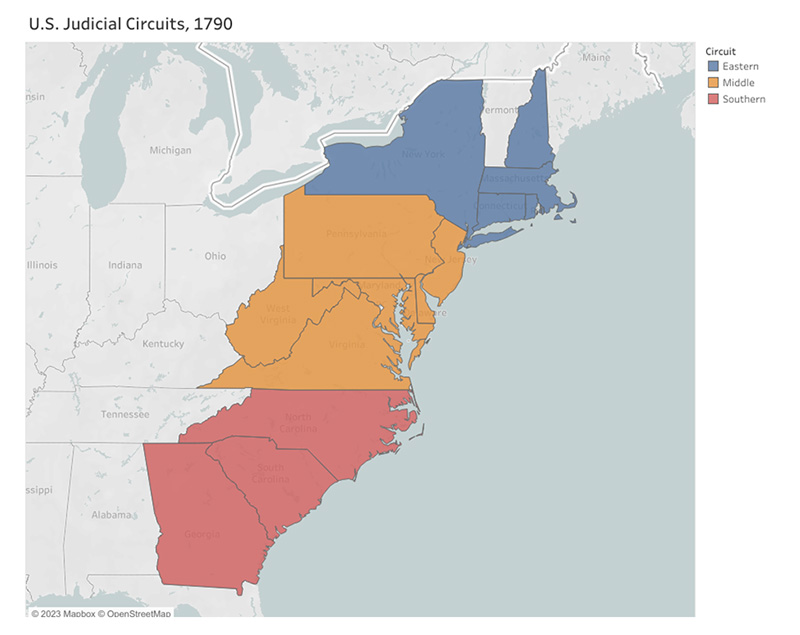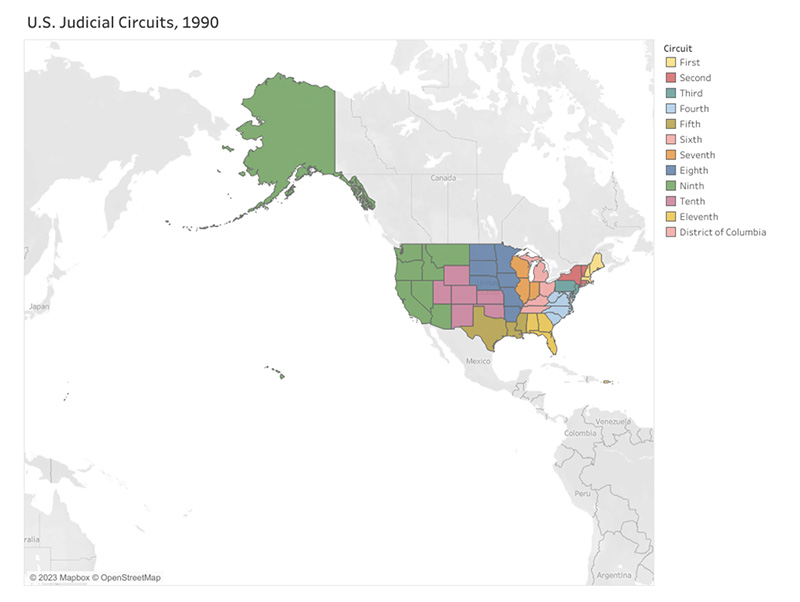“The judicial Power of the United States, shall be vested in one supreme Court, and such inferior Courts as the Congress may from time to time ordain and establish.” – United States Constitution, Article III, 1787
While Article III of the Constitution provided for a Supreme Court, establishing the rest of the federal courts was left to Congress. Fifteen months after the Constitution was ratified, the Judiciary Act of 1789, “An Act to Establish the Judicial Courts of the United States,” was passed by Congress and signed into law by President George Washington on September 24, 1789. In that act, Congress created the framework for the third branch of government which interprets the constitutionality of federal laws and settles other disputes about federal laws. Congress set the number of Supreme Court Justices at 6, 1 Chief Justice and 5 Associate Justices, and created district courts and circuit courts, though not the Courts of Appeals that exist today. During that time both district and circuit courts functioned as trial courts with district courts hearing primarily maritime and admiralty cases while circuit courts heard the bulk of the major civil and criminal cases and appeals from the lower courts.

At the time, separate judgeships were not created for the circuit courts. Instead, after the Court term, the six Supreme Court Justices served as circuit court judges and “rode circuit” for four-six months each year hearing cases in their assigned region. The Judiciary Act of 1789 divided the United States into 3 judicial circuits and each Justice was responsible for half of a regional circuit, often the half with their home state, but not always. For example, Justice Bushrod Washington was assigned Pennsylvania and New Jersey and not his home state of Virginia because Chief Justice John Marshall was also from Virginia. Riding circuit was challenging as the conditions Justices faced on unpaved dirt roads were often dangerous and lacked the comfort one might expect for a member of the nation’s highest court. Weather, lack of infrastructure, and primitive accommodations left the justices exhausted and sometimes ill or injured. In spite of the numerous complaints and resignations from early justices, the arduous practice continued until 1911.

The Federal Court System has changed significantly since the first judiciary act was passed. The number of Supreme Court Justices was increased to 10 and then Congress settled the number at 9 in 1869. There are now 13 Judicial Circuits in the United States and 94 Districts. The Evarts Act of 1891 created the U.S. Courts of Appeals and included staffing for U.S. circuit judges, contributing to the end of circuit riding. In 1911, Congress eliminated the older circuit courts giving way to the current structure of district trial courts serving as the primary trial courts and courts of appeals hearing appeals from the district courts in their region. In 1922, Congress created the Conference of Senior Circuit Judges, now known as chief judges, which was chaired by the Chief Justice. It was renamed the “Judicial Conference of the United States” in 1948 and a district judge from each circuit was included 9 years later. The last significant changes occurred in 1968 when Congress created the position of Magistrates, now Magistrate Judges, and Bankruptcy Judges. During its rich 234 year history, the federal court system has evolved to meet the needs of the nation and is continuously working to fulfill its mandate under the Constitution.
Sources:
- The Federal Judicial Center, Snapshots of Federal Judicial History, 1790-1990.
- Clare Cushman, Courtwatchers: Eyewitness Accounts in Supreme Court History.
- Gerard N. Magliocca, Washington’s Heir: The Life of Bushrod Washington, (Oxford University Press, 2022).




